Pensacola
Pensacola was founded in 1698 on Santa Rosa Island, the site of a 1559 Spanish settlement that lasted only 2 years. It was named after the Panzacola Indians who lived nearby. In 1719 it was taken by the French, who stayed for three years before the Spanish returned. A hurricane destroyed Pensacola in 1753 but it was rebuilt the following year on its current site on the mainland. British rule from 1763 saw Pensacola become the capital of West Florida, a territory that extended west to the Mississippi River. West Florida was loyal to the British Crown during the Revolutionary War but in 1783 Florida returned to Spanish control until in 1821 it was ceded to the USA. The Civil War saw the Confederacy hold Pensacola for only 16 months and it was burned when captured by Union forces. It was rebuilt and grew into a busy port handling a wide range of goods but it went into decline during the Great Depression.
Clara Barkley Dorr House
Historic Pensacola Village is a collection of twenty seven 19th century homes and buildings, eleven of which are open to the public as museums. The Clara Barkley Dorr House is one such museum. This well preserved Greek Revival two story home was built in 1871 for the widow of lumber tycoon Eben Dorr. In 1974 the house was added to the National Register of Historic Places. Tours are available starting at the Tivoli House at 205 East Zarazoga, but if you want to see the house don’t visit Pensacola on a Sunday or Monday as Historic Pensacola Village is closed.
T T Wentworth Museum
This Spanish Revival style building building opened in 1907 as the Pensacola City Hall. T. T. Wentworth Junior was local historian and collector who established a museum in 1957 in a roadside stand at Ensley, north of Pensacola. Wentworth offered to donate his collection to the state provided that a permanent home could be found in Pensacola. When a new City Hall was built in 1985, the old one was renovated and in 1988 it opened as the T.T. Wentworth, Jr. Florida State Museum. One floor houses some of the more eccentric items from Wentworth’s collection (such as a mummified cat) while the other two floors illustrate life in the Florida Panhandle over the centuries including many items from Wentworth’s collection. The museum is part of Historic Pensacola Village.
Old Christ Church from Seville Square
This Episcopal Church built in the Norman Gothic style was completed in 1832. During the Civil war the entire congregation fled to Alabama and the Union Army to used the church as a hospital and sleeping quarters. Major renovation took place between 1878 and 1879 including the addition of a stained glass window called ‘Light of the World’ over the altar. A new church was built in 1903 and all of the stained glass windows were moved to the new church. The old church was deconsecrated in 1935 and was used as a public library up to 1959 when it became Pensacola Historical Museum. In 1995 it was leased to Historic Pensacola Village who have restored the church. Click Tab 2 to see a closer view of the church.
Click on Minimap to navigate
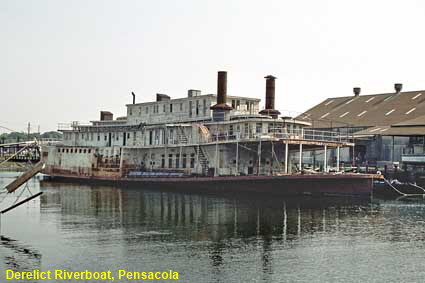
Derelict Riverboat, Pensacola
This 1982 picture shows what is probably the remains of the USCG Cutter ‘Willow’ built in Dubuque, Iowa in 1927 and decommissioned in 1945. There are similarities to an undated picture of the Willow in her heyday and the differences broadly align with descriptions of the changes made after she was decommissioned. It is thought that in the 1970s she was bought by a Pensacola businessman who planned to convert her into a restaurant but this did not proceed. When we first wrote this page we were unable to track down what happened to her after that, and we would like to thank Clyde who emailed us with information about her current location. She is in Benalmadena on the Costa del Sol, Spain. She was taken there in 1996 after being refurbished either in Liverpool or Antwerp. She was used as a floating restaurant & bar called the USS Willow. Sadly the restaurant & bar business lasted only a few years, so once again she is derelict although pictures suggest that she is in a better condition than she was when we saw her in Pensacola.
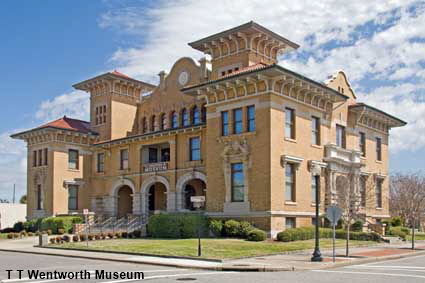

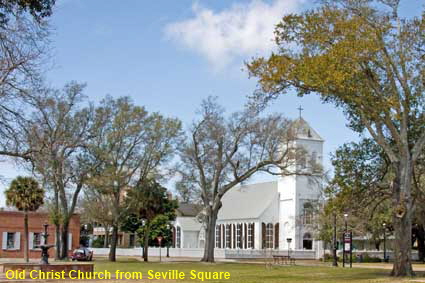
Vintage vehicles outside Seville Quarter
In 1967 a dilapidated brick warehouse on East Government Street which was once the home of the Pensacola Cigar and Tobacco Company became Rosie O'Grady's Warehouse, a beer-and-peanuts saloon specialising in Dixieland jazz. It was founded by Bob Snow, a musician in Pensacola jazz band South Hangar Six. Rosie O'Grady's was an immediate success and Snow quickly opened other adjacent entertainment venues, calling the whole complex The Seville Quarter. Snow sold the Seville Quarter in 1985 but in 1987 the complex closed due to bankruptcy of the new owners. It reopened in 1988 with Bob Snow back at the helm. This picture shows Rosie O'Grady's which was originally a plain warehouse building but was remodelled in 1983.

Escambia County Court House
Increasing trade through the port of Pensacola resulted in a three storey wooden federal customs house being built in 1854. It burned down in 1880. A replacement building, constructed of limestone to reduce fire risk, opened in 1887. The new building housed the post office and federal court as well as customs operations. By the 1930s federal operations had outgrown the building and the building then used as the Escambia County Court House had also become too small. The federal and county governments did a swap, with the old customs house becoming the new Escambia County Court House while a new United States Post Office and Court House was built on the old county court site.
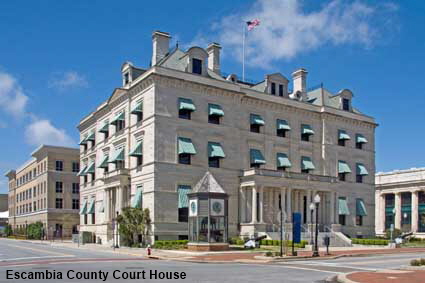
DLU180219


To move forwards or backwards through the Florida trail click the arrows above, or select your next destination on the Minimap.
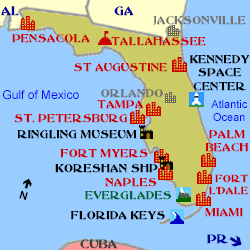

© Mike Elsden 1981 - 2025
The contents of this page may not be reproduced in full or in part without permission